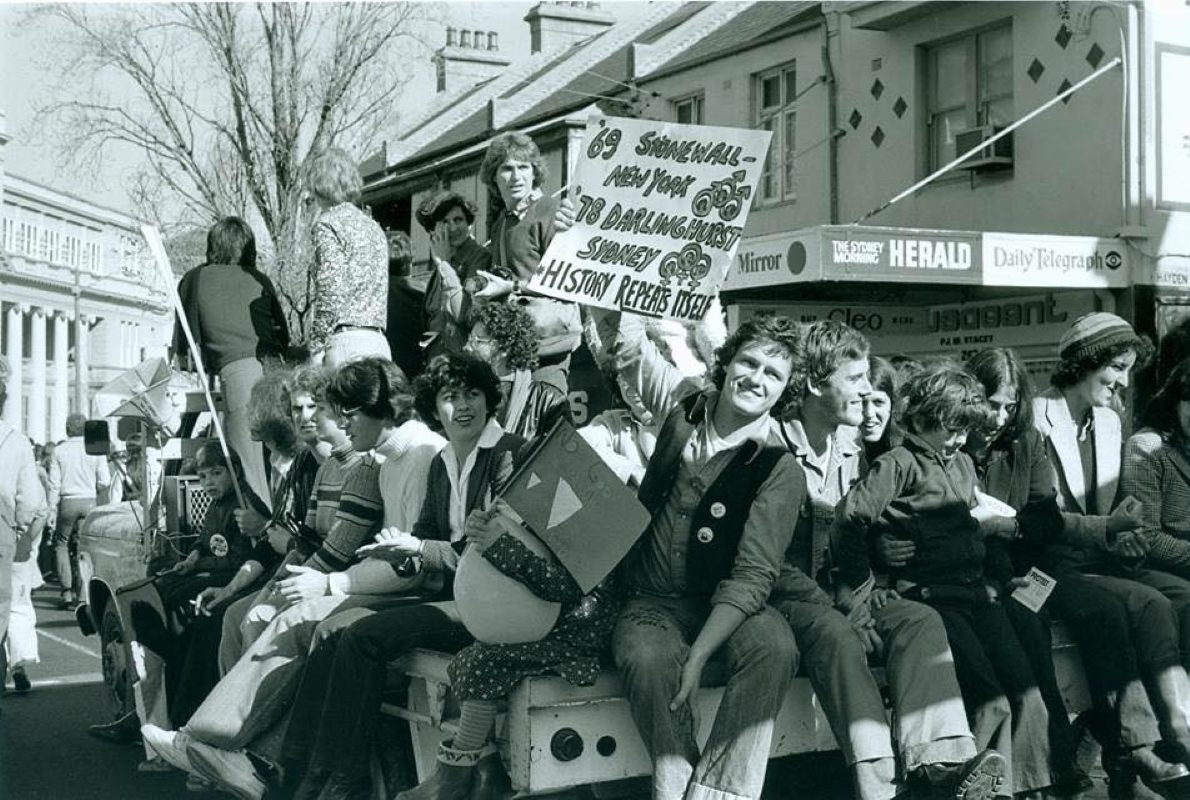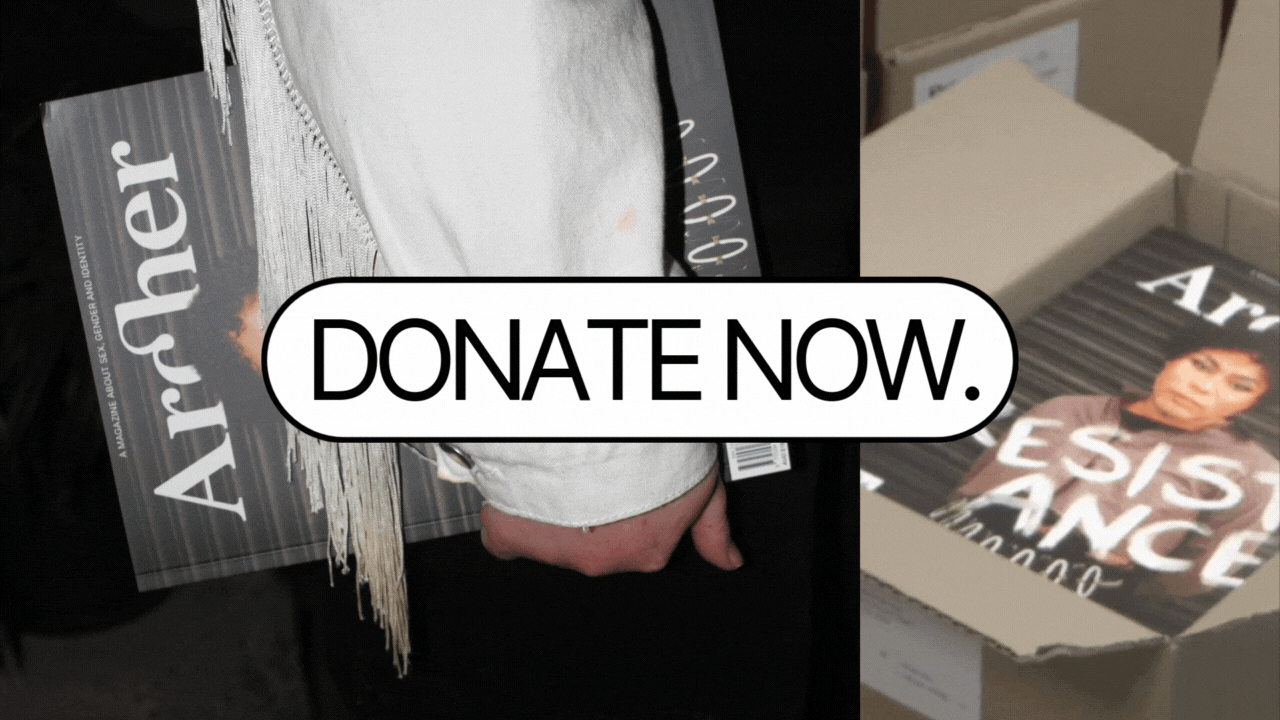Queer history of Sydney: Reflections from a gay tour guide
By: Michael Frommer

Content note: This story discusses homophobia, police violence, the criminalisation of queer people and colonisation.
“I see why we’re starting here,” one of my guests said. “All those tight-torsoed Greek statues really are quite gay.”
He wasn’t wrong. The Archibald Memorial Fountain does reek of the homoerotic.
But that’s not the reason my queer history of Sydney walking tours start there. Rather, it exemplifies one of the tour’s central themes: making the invisible visible.
The Archibald Fountain has a hidden history as a beat, where same-sex attracted men met to hook up. This use of the space started shortly after it was built in 1932, and continued into the 1950s.
Its proximity to the St James Station toilets, as well as to nearby department stores such as David Jones, made it a very lucrative spot.
The goal of my walking tours is to make this, and other hidden queer histories, known.
Image: The 78ers, photographer unknown.
As I led the tour group across to Hyde Park South, I pointed up the road.
“That Coca-Cola sign at the end there, that’s Kings Cross. That’s another important site of the city’s queer history, not least because it was the place where police brutally metered out violence at the first Mardi Gras, on 24 June in 1978,” I told the group.
Growing up in the ’90s in suburban Sydney, I had no queer role models around me. I certainly didn’t know from an early age that I was attracted to other boys.
As a curious adolescent, it was a video shop in Kings Cross that first allowed me to borrow (straight) porn. They didn’t care about proof of age.
I quickly realised that I was focused on the men in this porn, no matter how hard I tried to convince myself that it was just incidental to watching the women. It was some serious psychological gymnastics.
“The violence that queer folks were subjected to on that night in June occurred against the backdrop of ongoing laws that criminalised homosexuality,” I explained to my group.
I had indeed read those very laws. In my teens years, around the time I’d watched those grainy porn images, I stumbled on an unexpected source of validation: Section 79 of an old version of the NSW Crimes Act, from roughly 1982.
My oldest sister had started studying law at UNSW. On a few occasions, I found myself alone in our study where her uni textbooks lived. Buried in one was an old version of the NSW Crimes Act.
I can no longer remember if I looked for references to homosexuality deliberately or if it was inadvertent, but I recall that on many occasions, when I was alone, I found myself studying the provision that made anal sex illegal. It read:
Whosoever commits the abominable crime of buggery… shall be liable to imprisonment for fourteen years.
Reading it exhilarated me. It was confirmation that something I had thought about, but never breathed a word of, was actually real. The word buggery was something erotic. I read it again and again. Somehow it made me feel valid, my desires more tangible.
Ironically, learning about this prohibition of homosexuality only fuelled my curiosity.
Within the vicinity of Hyde Park North, I pointed out to guests some of the colonial era structures still standing: the Supreme Court buildings, St James’ Church and the Hyde Park Barracks.
“These imposing edifices of the colonial period contained many stories,” I told them.
Due to criminalisation of homosexuality, some of the most specific references we have to our queer forebears are in colonial records, particularly those related to the criminal justice system.
One record from the mid-19th century includes the Chaplain of Fremantle Prison describing the existence of “evil” homosexual desire in the institution:
What will ensue when we have thousands of men cooped up in the colony without wives and unable to seek them elsewhere. Evil will be the result – too humiliating for the mind to dwell upon – too revolting to name… That moral evil of far greater magnitude, which has of old brought down the signal judgment of Heaven, will result.
Another existing letter from the same period is from Tasmanian convict Denis Prendergast, writing to his ‘Dear Jack’ prior to being hanged for leading a prisoner mutiny. It’s considered the earliest known gay love letter in so-called Australia.
I hope you wont forget me when I am far away and all my bones is moldered away. I have not closed an eye since I lost sight of you your precious sight was always a welcome and loving charming spectacle. Dear Jack I value Death nothing but it is in leaving you my dear behind and no one to look after you… The only thing that grieves me love is when I think of the pleasant nights we have had together. I hope you wont fall in love with no other man when I am dead and I remain your True and loving affectionate Lover.
Through tireless research and work, historians and queer communities have brought to the fore some of these stories.
“Though NSW decriminalised homosexuality in 1984, homophobia remained,” I told my tour group.
We were standing by The Wall on Darlinghurst Road, a historically famous spot for cruising and male sex work.
The Wall was a site of work – a means for some to survive and earn a living. At the same time, it could be a place of danger, with exploitation and violence at the hands of some clients.
Its role as a place of street-based male sex work has largely ceased, but for decades, it was an important place of connection.
As a teenager in suburban Sydney, my desire to connect intimately with other gay people was strong, but the available methods to do so were limited.
I wanted more nourishment for my exploration. With the non-existent internet, and no knowledge of cruising, I leafed through the Northshore Times, where I found an ad that offered same-sex connection.
It outlined a service that allowed you to create a basic profile, saying who you were and what you were looking for.
It was free, and included the ability to select someone by using the touch-tone dialling. You would send a quick voice message, maximum 10 seconds.
Without a credit card of my own, and wanting to avoid phone bill charges that would cause questions, it was perfect!
Through this method, I started to chat to a man, and over a few months got to know each other. We exchanged sexual messages that, like the porn I’d seen, were grist to the mill for my self-exploration.
Keeping it safe, we never met for sex. We did, however, exchange messages about same-sex porn.
I told him how there was no gay porn at the Kings Cross video shop, so he offered to send some. As I couldn’t risk it arriving at my home mailbox, I decided to open a post office box.
Within a few weeks, the videos arrived. I was equal parts scared and excited.
I put one tape in the machine, and after its usual whirring, there was an image: a moving image of a handsome, dark-haired man.
My mouth was dry. The anticipation was intense. So was the rising pressure under my shorts. Before long, the second guy was on screen.
In what seemed like some act of magic, they started to kiss. Two. Men. Kissing. This was unthinkable. This was beautiful.
At this point, I realised that I needed to make sure that the tissue box was within easy reach. As much as I wanted to watch the rest of the tape, that would not happen this first time.
Afterwards, I was in a dreamlike state. It was thrilling, and thoroughly emotionally satisfying.
The thing I had been dreaming about, I had finally just seen with my own eyes. I felt unadulterated joy.
In seeing these men, I felt seen. And it felt good.
“So, here we are at Taylor Square. This was the site of the first Mardi Gras,” I explained at the tour’s final stop.
This was where it happened. That is, the good part. The bad part came up the road.
Taylor Square was the starting point of that night, full of the joy and euphoria of hundreds of gay liberation activists. Together, all boom-boxed up, they played gay liberation anthems like ‘Glad To Be Gay’ and ‘Ode to a Gym Teacher’.
Some dressed up, and some wore disguises – only able to attend anonymously.
They were claiming space, marking the anniversary of the Stonewall riots nine years earlier in New York City.
Later that night of the first Mardi Gras, up the road in Kings Cross, it horribly unravelled: unprovoked violence, beatings and then arrests at the hands of police.
The names, addresses and occupations of those arrested were published in the Sydney Morning Herald the next day, leading many to lose jobs and relationships.
The events of that fateful evening, when our queer forebears bravely stood up against violence and discrimination, were a blend of powerful and terrifying.
“Subsequent generations are indebted to them for what they did,” I told my group.
“They made themselves seen and heard; they made themselves undeniably visible. It was unthinkable, and it was beautiful.”
1 Comment
Leave a Comment Cancel Reply
Related stories...
- Something went wrong, no related stories were found.






The Archibald fountain was also adjacent to Boomerang Street and Haigh Avenue (no longer in existence), both very busy cruising areas right through WW2 and the Vietnam R&R period, for both gay hookups and in the 1930s, a well-known area for men down on their luck during the Great Depression, selling themselves to punters who drove past in their cars.